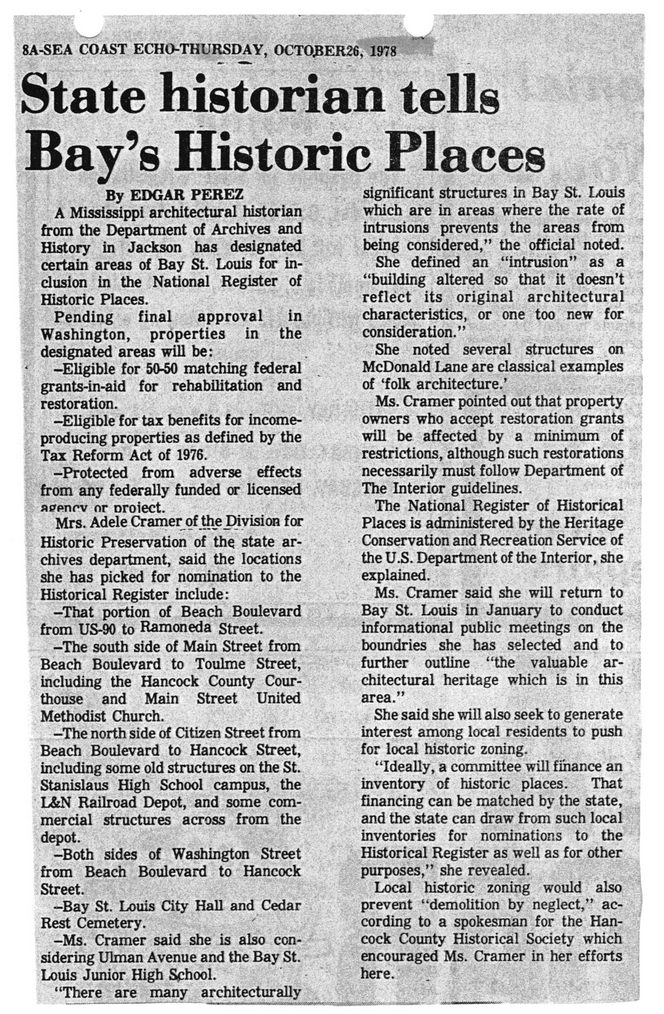This text was obtained via automated optical character recognition.
It has not been edited and may therefore contain several errors.
8A-SEA COAST ECHO-THURSDAY, 0CT03ER26, 1978 State historian tells Bay’s Historic Places By EDGAR PEREZ A Mississippi architectural historian from the Department of Archives and History in Jackson has designated certain areas of Bay St. Louis for inclusion in the National Register of Historic Places. Pending final approval in Washington, properties in the designated areas will be: -Eligible for 50-50 matching federal grants-in-aid for rehabilitation and restoration. -Eligible for tax benefits for income-producing properties as defined by the Tax Reform Act of 1976. -Protected from adverse effects from any federally funded a- licensed napnrv or Droiect. Mrs. Adele Cramer of the Division for Historic Preservation of the state archives department, said the locations she has picked for nomination to the Historical Register include: -That portion of Beach Boulevard from US-90 to Ramoneda street. -The south side of Main Street from Beach Boulevard to Toulme Street, including the Hancock County Courthouse and Main Street United Methodist Church. -The north side of Citizen Street from Beach Boulevard to Hancock Street, including some old structures on the St. Stanislaus High School campus, the L&N Railroad Depot, and some commercial structures across from the depot. -Both sides of Washington Street from Beach Boulevard to Hancock Street. —Bay St. Louis City Hall and Cedar Rest Cemetery. -Ms. Cramer said she is also considering Ulman Avenue and the Bay St. Louis Junior High School. “There are many architecturally significant structures in Bay St. Ixmis which are in areas where the rate of intrusions prevents the areas from being considered,” the official noted. She defined an “intrusion” as a “building altered so that it doesn’t reflect its original architectural characteristics, or one too new for consideration.” She noted several structures on McDonald Lane are classical examples of ‘folk architecture.’ Ms. Cramer pointed out that property owners who accept restoration grants will be affected by a minimum of restrictions, although such restorations necessarily must follow Department of The Interior guidelines. The National Register of Historical Places is administered by the Heritage Conservation and Recreation Service of the U.S. Department of the Interior, she explained. Ms. Cramer said she will return to Bay St. Louis in January to conduct informational public meetings on the boundries she has selected and to further outline “the valuable architectural heritage which is in this area.” She said she will also seek to generate interest among local residents to push for local historic zoning. “Ideally, a committee will finance an inventory of historic places. That financing can be matched by the state, and the state can draw from such local inventories for nominations to the Historical Register as well as for other purposes,” she revealed. Local historic zoning would also prevent “demolition by neglect,” according to a spokesman for the Hancock County Historical Society which encouraged Ms. Cramer in her efforts here.

Hancock County History General Newspaper Clippings Adele-Cramer-Architecture-Historian-1978-(1)